英语语义学讲义(上)
- 格式:ppt
- 大小:45.50 KB
- 文档页数:19
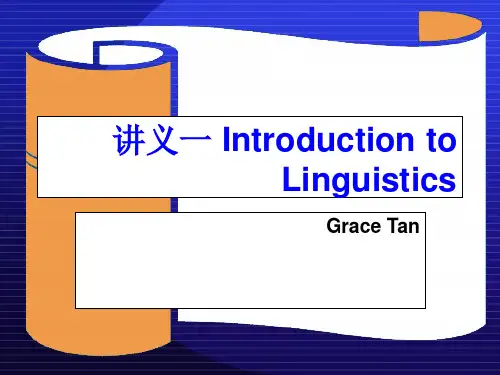
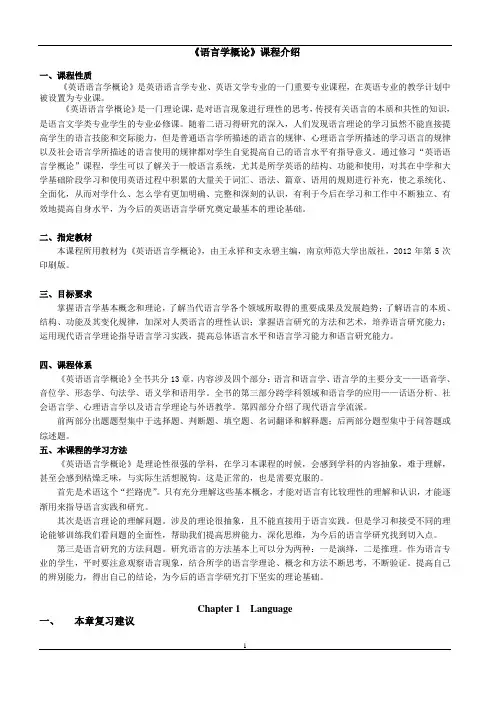
《语言学概论》课程介绍一、课程性质《英语语言学概论》是英语语言学专业、英语文学专业的一门重要专业课程,在英语专业的教学计划中被设置为专业课。
《英语语言学概论》是一门理论课,是对语言现象进行理性的思考,传授有关语言的本质和共性的知识,是语言文学类专业学生的专业必修课。
随着二语习得研究的深入,人们发现语言理论的学习虽然不能直接提高学生的语言技能和交际能力,但是普通语言学所描述的语言的规律、心理语言学所描述的学习语言的规律以及社会语言学所描述的语言使用的规律都对学生自觉提高自己的语言水平有指导意义。
通过修习“英语语言学概论”课程,学生可以了解关于一般语言系统,尤其是所学英语的结构、功能和使用,对其在中学和大学基础阶段学习和使用英语过程中积累的大量关于词汇、语法、篇章、语用的规则进行补充,使之系统化、全面化,从而对学什么、怎么学有更加明确、完整和深刻的认识,有利于今后在学习和工作中不断独立、有效地提高自身水平,为今后的英语语言学研究奠定最基本的理论基础。
二、指定教材本课程所用教材为《英语语言学概论》,由王永祥和支永碧主编,南京师范大学出版社,2012年第5次印刷版。
三、目标要求掌握语言学基本概念和理论,了解当代语言学各个领域所取得的重要成果及发展趋势;了解语言的本质、结构、功能及其变化规律,加深对人类语言的理性认识;掌握语言研究的方法和艺术,培养语言研究能力;运用现代语言学理论指导语言学习实践,提高总体语言水平和语言学习能力和语言研究能力。
四、课程体系《英语语言学概论》全书共分13章,内容涉及四个部分:语言和语言学、语言学的主要分支——语音学、音位学、形态学、句法学、语义学和语用学。
全书的第三部分跨学科领域和语言学的应用——话语分析、社会语言学、心理语言学以及语言学理论与外语教学。
第四部分介绍了现代语言学流派。
前两部分出题题型集中于选择题、判断题、填空题、名词翻译和解释题;后两部分题型集中于问答题或综述题。
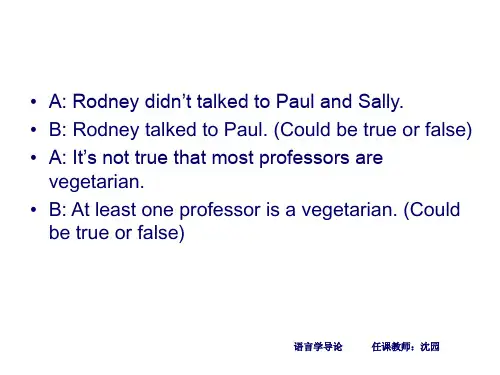

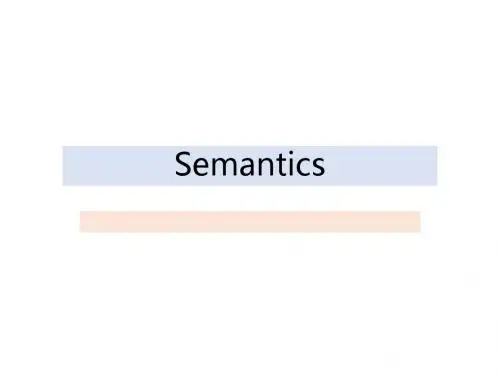


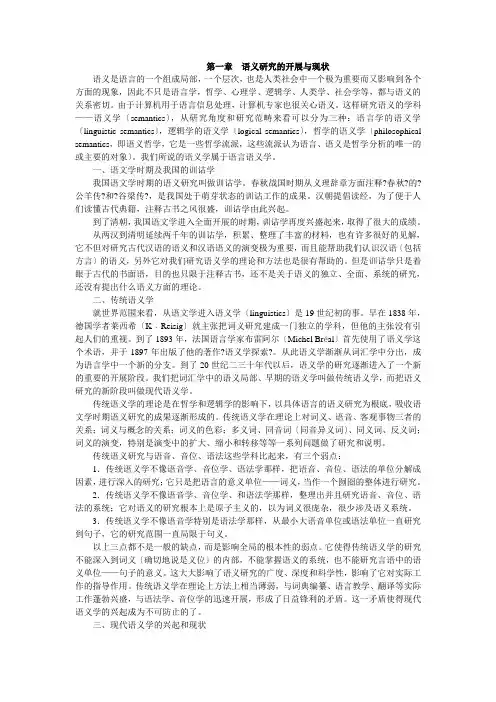
第一章语义研究的开展与现状语义是语言的一个组成局部,一个层次,也是人类社会中一个极为重要而又影响到各个方面的现象,因此不只是语言学,哲学、心理学、逻辑学、人类学、社会学等,都与语义的关系密切。
由于计算机用于语言信息处理,计算机专家也很关心语义。
这样研究语义的学科——语义学〔semantics〕,从研究角度和研究范畴来看可以分为三种:语言学的语义学〔linguistic semantics〕,逻辑学的语义学〔logical semantics〕,哲学的语义学〔philosophical semantics,即语义哲学,它是一些哲学流派,这些流派认为语言、语义是哲学分析的唯一的或主要的对象〕。
我们所说的语义学属于语言语义学。
一、语文学时期及我国的训诂学我国语文学时期的语义研究叫做训诂学。
春秋战国时期从义理辞章方面注释?春秋?的?公羊传?和?谷梁传?,是我国处于萌芽状态的训诂工作的成果。
汉朝提倡读经,为了便于人们读懂古代典籍,注释古书之风很盛,训诂学由此兴起。
到了清朝,我国语文学进入全面开展的时期,训诂学再度兴盛起来,取得了很大的成绩。
从两汉到清明延续两千年的训诂学,积累、整理了丰富的材料,也有许多很好的见解,它不但对研究古代汉语的语义和汉语语义的演变极为重要,而且能帮助我们认识汉语〔包括方言〕的语义,另外它对我们研究语义学的理论和方法也是很有帮助的。
但是训诂学只是着眼于古代的书面语,目的也只限于注释古书,还不是关于语义的独立、全面、系统的研究,还没有提出什么语义方面的理论。
二、传统语义学就世界范围来看,从语文学进入语义学〔linguistics〕是19世纪初的事。
早在1838年,德国学者莱西希〔K﹒Reisig〕就主张把词义研究建成一门独立的学科,但他的主张没有引起人们的重视。
到了1893年,法国语言学家布雷阿尔〔Michel Bréal〕首先使用了语义学这个术语,并于1897年出版了他的著作?语义学探索?。
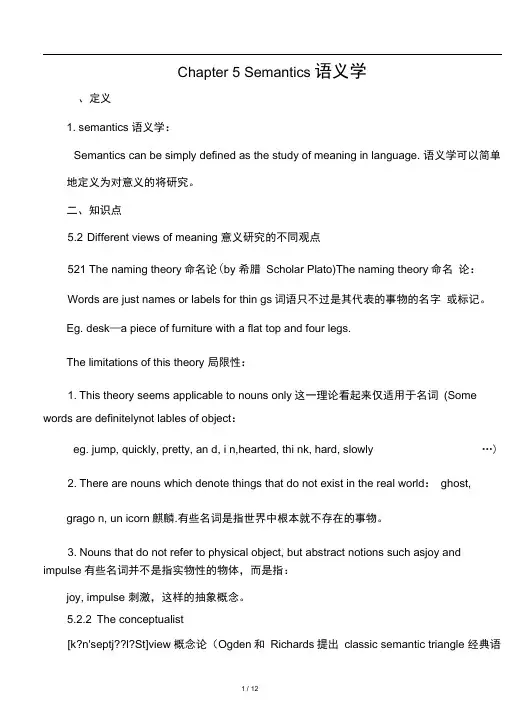
Chapter 5 Semantics 语义学、定义1. semantics 语义学:Semantics can be simply defined as the study of meaning in language. 语义学可以简单地定义为对意义的将研究。
二、知识点5.2 Different views of meaning 意义研究的不同观点521 The naming theory命名论(by 希腊Scholar Plato)The naming theory命名论:Words are just names or labels for thin gs词语只不过是其代表的事物的名字或标记。
Eg. desk—a piece of furniture with a flat top and four legs.The limitations of this theory 局限性:1. This theory seems applicable to nouns only这一理论看起来仅适用于名词(Some words are definitelynot lables of object:eg. jump, quickly, pretty, an d, i n,hearted, thi nk, hard, slowly …)2. There are nouns which denote things that do not exist in the real world: ghost,grago n, un icorn麒麟.有些名词是指世界中根本就不存在的事物。
3. Nouns that do not refer to physical object, but abstract notions such asjoy and impulse有些名词并不是指实物性的物体,而是指:joy, impulse 刺激,这样的抽象概念。
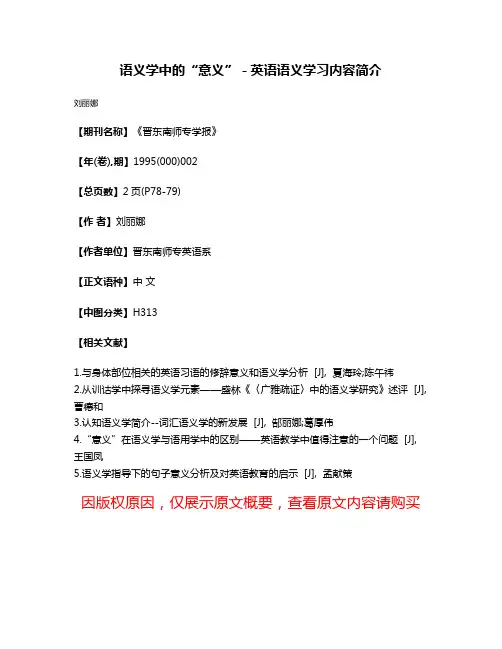
语义学中的“意义”-英语语义学习内容简介
刘丽娜
【期刊名称】《晋东南师专学报》
【年(卷),期】1995(000)002
【总页数】2页(P78-79)
【作者】刘丽娜
【作者单位】晋东南师专英语系
【正文语种】中文
【中图分类】H313
【相关文献】
1.与身体部位相关的英语习语的修辞意义和语义学分析 [J], 夏海玲;陈午祎
2.从训诂学中探寻语义学元素——盛林《〈广雅疏证〉中的语义学研究》述评 [J], 曹德和
3.认知语义学简介--词汇语义学的新发展 [J], 郜丽娜;葛厚伟
4.“意义”在语义学与语用学中的区别——英语教学中值得注意的一个问题 [J], 王国凤
5.语义学指导下的句子意义分析及对英语教育的启示 [J], 孟献策
因版权原因,仅展示原文概要,查看原文内容请购买。

语义学各个领域对语义学的看法语义学(Semantics),也作“语意学”,是一个涉及到语言学、逻辑学、计算机科学、自然语言处理、认知科学、心理学等诸多领域的一个术语。
虽然各个学科之间对语义学的研究有一定的共同性,但是具体的研究方法和内容大相径庭。
一、语言学的语义学研究目的在于找出语义表达的规律性、内在解释、不同语言在语义表达方面的个性以及共性;其主要有三个分支:1结构主义语义学:从20世纪美国结构主义语言学发展而来,研究内容是词汇的意义和结构,如义素分析、语义场等,也可称为词汇语义学,词和词之间的各种关系是词汇语义学研究的一个方面,例如同义词、反义词,同音词等,找出词语之间的细微差别。
2生成语义学:20世纪六七十年代流行于生成语言学内部的一个语义学分支, 借鉴了结构语义学对义素的分析方法,比照生成音系学的音位区别特征理论,主张语言的最深层的结构是义素,通过句法变化和词汇化的各种手段而得到表层的句子形式。
3形式语义学:最初的研究开始于蒙太古以数理逻辑方法对英语的研究,后来经过语言学家和哲学家的共同努力,发展成为一个独立的学科,并且摒弃了蒙太古对生成语言学的句法学的忽视,强调语义解释和句法结构的统一,从而最终成为生成语言学的语义学分支。
二、逻辑学的语义学是对一个逻辑系统的解释,着眼点在于真值条件,不直接涉及自然语言;现代的逻辑学,或者说形式逻辑、数理逻辑等,其目的是设计出来一套形式语言系统,并对其作出语义解释。
这样的形式语言系统是一个个抽象的封闭体系.一个逻辑系统通常由三个部分组成,即词汇部分、句法部分和基于模型论的语义部分。
所谓的词汇部分就是列举出一个形式系统所使用的所有符号,句法部分是这些符号的组合规则,规定什么样的符号序列可以是这个系统的句子,语义部分是对合格句子的解释,这样的解释通常是:在一个模型中进行的对真值条件推导。
逻辑学的语义学着眼点在于逻辑系统的语义解释,是一个理想化的模型系统,不直接涉及自然语言。
Chapter 5 Semantics 语义学1.What is semantics?什么是语义学?Semantics can be simply defined as the study of meaning in language.语义学可定义为对语言意义的研究。
2.Some views concerning the study of meaning语义研究的几种主要理论1)The naming theory 命名论It was proposed by the ancient Greek scholar Plato. According to this theory, the linguistic forms or symbols, in other words, the words used in a language are taken to be labels of the objects they stand for. So words are just names or labels for things.命名论是最原始的语义理论,是古希腊学者柏拉图提出的。
该理论把词看作是该词所指事物的名称或标记。
2)The conceptualist view 意念论The conceptualist view holds that there is no direct link between a linguistic form and what it refers to; rather, in the interpretation of meaning they are linked through the mediation of concepts in the mind.意念论认为,语言形式及其所代表的对象之间(即语言与现实世界之间)没有直接联系;确切地说,在理解语义时,是通过大脑中存在意念这一中介物来联系的。
Chapter 1 Invitations to LinguisticsI. The definition of languageLanguage is a system of arbitrary vocal symbols used for human communication. This definition has revealed five essential factors of language: systematic系统性, arbitrary任意性, vocal口头, symbolic 符号性and most importantly human specific.To give the briefest definition, language is a means of verbal communication.Language distinguishes us from animals because it is far more sophisticated than any animal communication system.II. The Design features of language (语言的区别性特征)Design features refer to the defining properties of human languages that distinguish it from any animal system of communication.A framework was proposed by the American linguist Charles Hockett.1.Arbitrariness (任意性)The widely accepted meaning of this feature which was discussed by Saussure(索绪尔)first refers to the fact that the forms of linguistic signs bear no natural relationship to their meaning.It is the core feature(核心特征) of language, which refers to the fact that there is no logical or intrinsic connection between a particular sound and the meaning it is associated with. It is not entirely arbitrary atall levels. Some words, such as the ones created in the imitation of sounds by sounds are motivated in a certain degree.其他书表述:Language is arbitrary. This means that there is no logical relationship between meanings and sounds. While language is arbitrary by nature, it is not entirely arbitrary. The arbitrary nature of language is a sign of sophistication and it makes it possible for language to have an unlimited source of expressions.2. Duality (二重性)Duality refers to the property of having twolevels of structures, such that units of the primary level are composed of elements of the secondary level and each of two levels has its own principles of organization. The property of duality only exists in such a system, namely, with both elements (e.g. sounds, letters) and units (e.g. words).其他书表述:Language is a system, which consists of two sets of structures, or two levels. At the lower or the basic level there is a structure of sounds, which is meaningless.Each human language is organized into two basic systems: a system of sounds and a system of meanings. This is called the duality of language.3.Creativity (创造性)Creativity, sometimes also “productivity”, means language is resourceful because of its duality and its recursiveness, which enables human beings to produce and understand an infinitely large number of sentences in our native language, including the sentences which were never heard before.Also called design features (C. F.Hockett, A Course in Modern Linguistics, 1958)4.Displacement(移位性)Displacement means that human languages enable their users to symbolize objects, events and concepts which are notpresent (in time and space) at the moment of communication.Displacement benefits human beings by giving them the power to handle generalizations and abstractions.5.Cultural Transmission (文化传递性)Language is culturally transmitted. It cannot be transmitted through heredity(遗传).While human capacity of language has a genetic basis, i.e., we were all born with the ability to acquire language, the details of any language system are not genetically transmitted, but instead have to be taught and learned.6.Interchangeability (互换性)Interchangeability refers to the fact that man can both produce and receive message, and his roles as a speaker and a hearer can be exchanged at ease.III. Origin of language1.Bilical account (圣经记载)Language was God’s gift to human beings.2.The bow-wow theory (“汪汪”理论) Language was an imitation of natural sounds, such as the cries of animals, like quack,cuckoo.3.The pooh-pooh theory (“噗噗”理论) Language arose from instinctive emotional cries, expression of pain or joy. Oh, Ah, Aiyo4.The ye-he-ho theory (“哟-嘿-吼”理论)Language arose from the noises made by a group of people engaged in joint labour oreffort-lifting a huge hunted game, moving a rock, etc.5.The evolution theory (进化理论)Language originated in the process of labour and answered the call of social need.IV. Functions of languageJakobson (雅格布逊) established a well-known framework of language functions based on the six key elements of communication, namely: referential(conveymessage and information), poetic (indulge in language for its own sake), emotive(to express attitudes, feelings and emotions), conative(to persuade and influence others through commands and requests), phatic(to establish communion with others) and metalingual function (to clear up intensions and meaning).Halliday(韩礼德) proposes a theory of metafuncions of language, that is, language has IDEATIONAL(意念), INTERPERSONAL(人际) and TEXTUAL (语篇)functions. Ideational function constructs a model of experience as well as logical relations, interpersonal function enacts social relationships and textual function creates relevance to context.rmative function (信息功能)Language is used to tell something, to give information, or to reason things out. The informative function is regarded as the most important function. Declarative sentences(陈述句) serve this function.It is the major role of language. The use of language to record the facts is a prerequisite (先决条件) of social development.It is also called the ideational function (意念功能) in the framework of functional grammar(功能语法).2.Interpersonal function (人际功能)The interpersonal function is considered asthe most important sociological use of language, by which people establish and maintain their status in a society.In the framework of function grammar, this function is concerned with interaction between the addresser and addressee in the discourse situation and the addresser’s attitude toward what he speaks or writes about. For example, the ways in which people address others andrefer to themselves (e.g. Dear Sir, Dear Professor, Johnny, yours, your obedient servant) indicate the various grades of interpersonal relations.3.Performative function (施为功能)The performative function of language is primarily used to change the social status of persons, as in marriage ceremonies, the sentencing of criminals, the blessing of children, the naming of a ship at a launching ceremony, and the cursing of enemies. The kind of language employed in performative verbal acts is usually quiet formal and even ritualized(仪式化).(the Royal Wedding)4.Emotive function (感情功能)The emotive function of language is oneof the most powerful uses of language because it is so crucial in changing the emotional status of an audience for or against someone or something.God, My, Damn it, What a sight, Wow, Son of Bitch他妈的,他姥姥的5.Phatic function (寒暄功能)The term PHATIC COMMUNION originates from Malinowski’s study of the functions of language performed by Trobriand Islanders. (a Polish anthropoligist)This function refers to expressions that help define and maintain interpersonal relations, such as slangs, jokes, jargons, ritualistic exchanges, switches to social andregional dialects.おはようございます。
理论精讲-语言学 1理论精讲-语言学1(讲义)题量1-4题Part1语言学概述1.语言学的分类2.语言的本质特征3.语言的主要功能01语言学的分类02语言的本质特征(Design features)语言的本质特性,指的是人类固有的,有别于任何其他动物交流系统的特质。
任意性二重性创造性位移性变化传播性交换性1.任意性任意性(Arbitrariness)是指语言符号的形式与所表示的意义没有天然的联系。
teacher(English)せんせい(Japanese)老师(Chinese)(叫啥都可以)2.二重性3.创造性4.移位性5.文化传播性6.互换性1.任意性2.二重性二重性(duality)二重性指语言在结构上存在两个层次:低层次:c-o-f-f-e-e高层次:coffee有读音有意义补充:递归性(Recursiveness)无限制地反复利用相同的规则They don't know that we know they know....3.创造性4.移位性5.文化传播性6.互换性1.任意性2.二重性3.创造性能产性/创造性(Productivity/Creativity)词语通过新的使用方法能表达新的意思,并能立刻被没有遇到过这种用法的人所理解。
①ungelievable不给力的②She bought a book which was written by a teacher who taught in a school which was known for its graduates who...4.移位性5.文化传播性6.互换性1.任意性2.二重性3.创造性4.移位性移位性(Displacement)人类语言可以谈论到时间上(time)和空间上(space)并不可及的物体、时间或观点。
孔子、Shakespeare5.文化传播性6.互换性1.任意性2.二重性3.创造性4.移位性5.文化传播性文化的传习性(Cultural transmission√)是指人类语言依靠文化或习俗传统得以代代相传(from generation togeneration),而不是靠遗传延续。
引言1. 介绍leech (1983)语义学的背景和重要性语义学是语言学的一个重要分支领域,研究语言的意义和表示。
而Geoffrey Leech (1983)是一位英国著名的语言学家,他在语义学领域有着重要的贡献,其著作《语义学》被广泛引用和研究。
本文将对Leech (1983)语义学的主要观点和贡献进行深入探讨,以及其在语言学领域的影响和意义。
主要观点和贡献2. 阐述Leech (1983)对语义学的主要观点Leech (1983)认为,语言的意义不仅仅是词汇的意义,还包括了各种语言现象中的含义和意义。
他提出了“语义关系”、“语义角色”、“语义场”等概念,对语义学研究提供了新的视角和范式。
他通过对语言使用中的语境、语用和文化背景的分析,揭示了语义学研究中的一些重要问题,并提出了新的解决方案。
3. 探讨Leech (1983)对语言意义分类的贡献Leech (1983)在其著作中提出了一套完整的语义分类系统,将语义分为词法语义、句法语义、逻辑语义、语用语义和言外语义等几个方面,并对每个方面进行了深入的分析和讨论。
这一语义分类系统为语言学研究提供了重要的框架和方法,为语义学的进展和发展提供了重要的理论基础。
影响和意义4. 分析Leech (1983)对语义学研究的影响Leech (1983)的语义学理论具有重要的影响力,不仅在语言学领域,还在语言教学、自然语言处理、人工智能等领域有着广泛的应用。
他的语义分类系统和语义理论为语言学研究和语言教学提供了重要的理论支持,也为计算机语言处理和人机交互领域提供了重要的启示和参考。
5. 探讨Leech (1983)语义学对跨文化交流的意义语义学的研究不仅仅是对语言本身的研究,还涉及到文化、社会和心理等多个方面。
Leech (1983)的语义学理论对于跨文化交流和跨文化交际具有重要的意义,可以帮助人们更好地理解和研究不同语言和文化间的意义差异,也为跨文化交流提供了理论和方法支持。